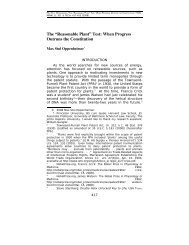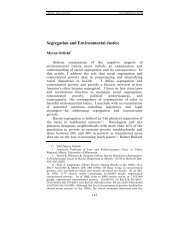An Organizational Approach to the Design of Patent Law
An Organizational Approach to the Design of Patent Law
An Organizational Approach to the Design of Patent Law
You also want an ePaper? Increase the reach of your titles
YUMPU automatically turns print PDFs into web optimized ePapers that Google loves.
6 VERTINSKY FINAL_JAD (DO NOT DELETE) 2/27/2012 2:20 PM<br />
274 MINN. J. L. SCI. & TECH. [Vol. 13:1<br />
Most <strong>of</strong> <strong>the</strong> existing research connecting patents <strong>to</strong> entrepreneurship<br />
has focused on <strong>the</strong> roles patents might play in obtaining<br />
financing for new ventures. The relationships between<br />
entrepreneurs, <strong>the</strong>ir employees, <strong>the</strong>ir financers, <strong>the</strong>ir suppliers,<br />
and <strong>the</strong>ir cus<strong>to</strong>mers can be usefully explored by looking at <strong>the</strong><br />
intersection <strong>of</strong> formal rules and governance structures. At <strong>the</strong><br />
pre-financing level, patents can serve an information function,<br />
signaling <strong>the</strong> value <strong>of</strong> intangible assets and human capital <strong>to</strong><br />
potential funders in a way that facilitates <strong>the</strong> financial transaction.<br />
266 <strong>Patent</strong>s can also facilitate financing <strong>of</strong> early stage ventures<br />
by providing inves<strong>to</strong>rs with property rights over intangible<br />
assets. 267 Post-financing, venture capital backed firms tend<br />
<strong>to</strong> have higher patenting. This can be explained in terms <strong>of</strong> <strong>the</strong><br />
higher innovation levels <strong>of</strong> venture-backed companies (a plus)<br />
or in terms <strong>of</strong> <strong>the</strong> short-term nature <strong>of</strong> venture capital strategies,<br />
with <strong>the</strong>ir interest in creating signals <strong>of</strong> market value <strong>to</strong><br />
allow for early exit. 268<br />
The organizational approach also provides opportunities <strong>to</strong><br />
tie in relevant research from o<strong>the</strong>r disciplines in order <strong>to</strong> refine<br />
patent strategies <strong>to</strong> promote entrepreneurship. At <strong>the</strong> level <strong>of</strong><br />
<strong>the</strong> firm, <strong>the</strong> management, operations research, and organizational<br />
design literature <strong>of</strong>fer interesting insights in<strong>to</strong> <strong>the</strong> connection<br />
between organizational structure, information systems,<br />
and knowledge generation and transfer, with under-explored<br />
implications for patent law. 269 Exploring firm structures that<br />
shape <strong>the</strong> institutional setup that would govern activities in a particular<br />
field.”).<br />
266. Clarisa Long, <strong>Patent</strong> Signals, 69 U. CHI. L. REV. 625, 627–28 (2002)<br />
(discussing patents as mechanisms for firms <strong>to</strong> signal <strong>the</strong>ir R&D capacity and<br />
<strong>the</strong> value <strong>of</strong> <strong>the</strong>ir intellectual assets <strong>to</strong> attract financing and licensing opportunities).<br />
267. See Eisenberg, supra note 36, at 1024–28.<br />
268. See, e.g., Simona Fabrizi, Steffen Lippert, Pehr-Johan Norbäck & Lars<br />
Persson, Venture Capital Financing <strong>of</strong> Innovation, <strong>Patent</strong>ing, and Long-Run<br />
Performance <strong>of</strong> Private Acquisitions (Massey U. C. <strong>of</strong> Bus. Res., Working Paper<br />
No. 13, 2010), available at http://ssrn.com/abstract=1629226 (<strong>to</strong> access article,<br />
select One-Click Download) (examining <strong>the</strong> relationship between venture capital<br />
financing, patent intensity, and firm performance in light <strong>of</strong> facts such as<br />
<strong>the</strong> higher patent count <strong>of</strong> VC intensive industries, and also studying <strong>the</strong> incentive<br />
effects such as role <strong>of</strong> patents in signaling company value prior <strong>to</strong> exit).<br />
269. The study <strong>of</strong> how firm structure influences knowledge management<br />
<strong>of</strong>fers an alternative entry point for studying characteristics <strong>of</strong> firms that are<br />
successful innova<strong>to</strong>rs. See Richard Baskerville & Alina Dulipovici, The Theoretical<br />
Foundations <strong>of</strong> Knowledge Management, 4 KNOWLEDGE MGMT. RES. &<br />
PRAC. 83, 90–92 (2006).






